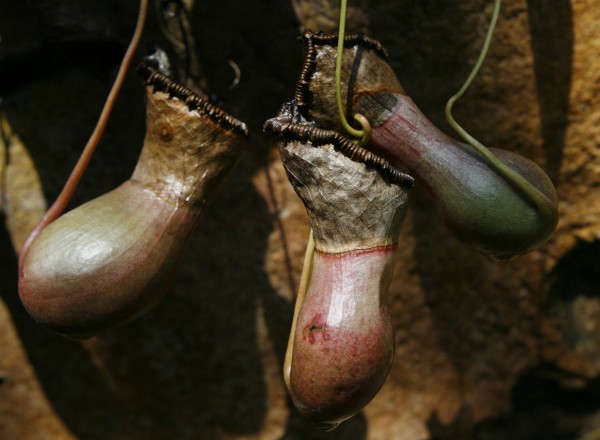Pitcher Plant Utilizes the Power of Rain to Trap and Digest Insects
| Benjie Batanes | | Oct 06, 2015 07:32 AM EDT |
(Photo : REUTERS/Daniel Munoz ) Three Nepenthes ventricosa are seen at the tropical section of the Royal Botanic Gardens in Sydney. Researchers have discovered that the Nepenthes gracilis uses rain drops to trap and digest insects.
A recent scientific study has discovered that a certain type of pitcher plant uses the power of rain to trap and digest insects such as ants. The Nepenthes gracilis is now under a new class, distinct from the two known classes.
Most carnivorous plants are either placed in the active class, such as the venus flytraps, or the passive class, where most pitcher plants belong. Although the Nepenthes is part of the pitcher plant family, it is the only one that uses outside forces to trap and eat preys. It does not even exert any effort in doing so.
Like Us on Facebook
The researchers closely examined the ingenious pitcher plant and found that it's lid is quite stiff compared to others. Bristol University researchers used various equipments, including cameras, to capture the Nepenthes's technique of trapping preys. Devices that measure vibrations coming from the plant were also used.
The images showed that when a raindrop hits the lid of the plant, a series of quick vibrations are released, causing insects on its leaf to lose balance and fall into the plant's pitcher. Once trapped below, the insects will slowly be consumed by the plant's digestive enzymes if they do not drown first. Researchers also found some kind of wax that reduces friction, is also present under the plant's lid.
One of the researchers Doctor Ulrike Bauer described the vibration of the Nepenthes plant after a drop of water hits its lid. The leaf springs back and forth with amazing speed, which probably causes insects to lose their balance and grip.
The doctor says this hunting method is not common. The Nepenthes uses cunning and speed to capture preys. The fact that it uses rain drops to help it trap insects is something most carnivorous plants do not usually do.
Bauer added that the plant is able to take advantage of rain drops because of its particular structure. Most pitcher plants have lids that are softer than those of the Nepenthes. The reseachers say the plant's stiff lid is where the strongest vibration occurs.
The study has been published in the PNAS journal.
Tagsnepenthes garcilis, pitcher plant, Carnivorous plant, flytrap, active carnivorous plant, passive carnivorous plant, PNAS Journal, plant's digestive enzymes, plant vibration
©2015 Chinatopix All rights reserved. Do not reproduce without permission
EDITOR'S PICKS
-

Did the Trump administration just announce plans for a trade war with ‘hostile’ China and Russia?
-

US Senate passes Taiwan travel bill slammed by China
-

As Yan Sihong’s family grieves, here are other Chinese students who went missing abroad. Some have never been found
-

Beijing blasts Western critics who ‘smear China’ with the term sharp power
-

China Envoy Seeks to Defuse Tensions With U.S. as a Trade War Brews
-

Singapore's Deputy PM Provides Bitcoin Vote of Confidence Amid China's Blanket Bans
-

China warns investors over risks in overseas virtual currency trading
-

Chinese government most trustworthy: survey
-

Kashima Antlers On Course For Back-To-Back Titles
MOST POPULAR
LATEST NEWS
Zhou Yongkang: China's Former Security Chief Sentenced to Life in Prison

China's former Chief of the Ministry of Public Security, Zhou Yongkang, has been given a life sentence after he was found guilty of abusing his office, bribery and deliberately ... Full Article
TRENDING STORY

China Pork Prices Expected to Stabilize As The Supplies Recover

Elephone P9000 Smartphone is now on Sale on Amazon India

There's a Big Chance Cliffhangers Won't Still Be Resolved When Grey's Anatomy Season 13 Returns

Supreme Court Ruled on Samsung vs Apple Dispute for Patent Infringement

Microsoft Surface Pro 5 Rumors and Release Date: What is the Latest?













